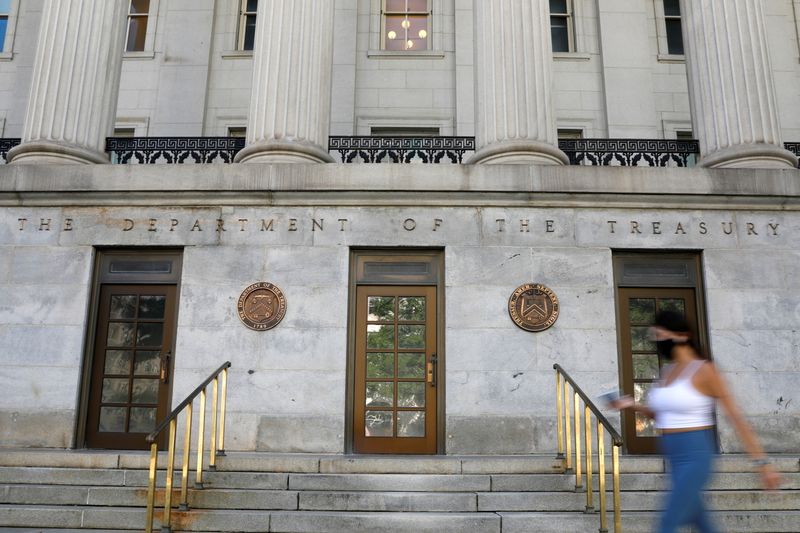By Jamie McGeever
ORLANDO, Florida (Reuters) -Any hope of sustaining U.S. fiscal accounts at such stretched levels and keeping the fragile bond market equilibrium intact may have to hinge on avoiding any recession at all - a cycle-busting scenario that seems far-fetched to many.
What's more, if the benign "soft landing" or "no landing" economic forecasts on which the already scary U.S. budget math is predicated fail to play out, the Federal Reserve may ultimately be forced to start buying bonds again.
The Treasury market is at a delicate juncture. Federal annual budget deficits over the next several years are projected to run into the trillions of dollars, and will need to be funded by increasingly wary lenders.
The risk is that the deficit and borrowing outlook is even more challenging than it looks, because these projections are based on macroeconomic forecasts that may turn out to be too optimistic.
Take the unemployment rate, currently at 3.9%. The non-partisan Congressional Budget Office's baseline scenario is for unemployment to rise to 4.2% this year, 4.5% in the following year, dip back to 4.3% in 2026, average 4.4% over the next two years and then average 4.5% over the five-year period through 2034.
History shows, however, that recessions are accompanied by far steeper rises in unemployment than that. Every recession in the past half century has been associated with unemployment rising at least two percentage points, usually more.
The fall in tax revenues and rise in benefits spending from an adverse shock of that nature would almost certainly widen deficits further and force Washington to issue more debt, resulting in higher bond yields.
Just how high would in part be determined by demand. But to be sure of keeping long-term borrowing costs under control the Federal Reserve may have to step in, U-turn on its balance sheet reduction drive, and resume full-on quantitative easing.
"The risk that the Fed monetizes excessive deficits in the next five to 10 years has to be taken seriously," says Willem Buiter, a former rate-setter at the Bank of England, adding that a return to something akin to permanent QE is "quite likely."
"But the Fed should be reducing its balance sheet significantly, and not be the buyer of first resort," Buiter notes.
No economic indicator moves the bond market more than jobs and inflation data. As Alex Etra at Exante Data notes, most of the increase in nominal bond yields over the last 18 months has been around non-farm payrolls and consumer price index and personal consumption expenditures inflation reports.
DEFICITS AND TERM PREMIUM
The CBO's baseline projections show the U.S. budget deficit widening to 6.1% of gross domestic product next year and not shrinking below 5% for the next decade.
In dollar terms, that's an annual shortfall of between $1.64 and $2.56 trillion every year for the next decade that the government has to plug, mostly through borrowing.
The annual U.S. budget balance is almost always in deficit, but rarely this deep - between World War Two and the Great Financial Crisis it exceeded 5% of GDP only once, in 1983.
International Monetary Fund estimates for the "general government fiscal balance" show the annual deficit out to 2029 even wider, from 6.0% to 7.1% of GDP.
In its "Fiscal Monitor" update in April the IMF warned that the U.S. Treasury's plans to issue more debt, coinciding with quantitative tightening, has probably fueled the recent increase in bond market volatility and rise in term premiums.
Term premium is the extra compensation investors demand for lending to the government over the long term instead of rolling over shorter-term loans. Rising term premiums are a reflection of higher risk aversion, and negative budgetary shocks are a prime source.
"Empirical evidence suggests that all else being equal, a 1 percentage point increase in the U.S. primary deficit is associated with a rise in term premiums of about 11 basis points in the quarters that follow," IMF economists found.
A rising term premium may also reflect changes in the make-up of demand for Treasuries, as "price-insensitive" buyers like foreign central banks see their market footprint shrink while "price-sensitive" buyers in the private sector increase theirs.
According to Barclays, the overseas private sector now owns more of the $25 trillion U.S. debt outstanding than the overseas official sector. All else equal, those who "choose" to buy Treasuries rather than those who "need" to buy them will demand more compensation for absorbing the increase in supply.
"This has implications for how Treasury supply will be received by markets, not just in terms of the term premium that is demanded to own Treasuries, but also the volatility of the rates markets," Barclays analysts wrote last month.
(The opinions expressed here are those of the author, a columnist for Reuters.)
(By Jamie McGeever; Editing by Paul Simao)
